Louise Nevelson. Wood Collage

During the Second World War, when materials like bronze were unavailable, Louise Nevelson became a compulsive collector of abandoned and discarded wood fragments that she assembled into freestanding sculptures. “No one was using wood at the time,” she observed, but wood was both a personal and practical material.1 Nevelson’s father was a builder and owner of lumberyards in Maine, and her brother and son were both trained craftsmen. The artist also collected from the streets ornately designed wood balusters, moldings, knobs, and other scraps of wood from buildings torn down in New York City’s postwar construction boom. Nevelson cut, stacked, nailed, glued, and painted these found wood fragments to build monochromatic collage sculptures. In 1978, after a fire devastated the organ at St. Mark’s Church near her East 7th Street apartment in Manhattan, decorative remnants were rescued and given to Nevelson, who used the pieces in a series of sculptures during the early 1980s, including Cascades-Perpendiculars II (Night Music) (1980–82). With a monochromatic coat of paint, she united the shattered world to create a new harmony.
Louise Nevelson, oral history interview with Arnold Glimcher, Archives of American Art, Smithsonian Institution, January 30, 1972, transcript available at aaa.si.edu/collections/interviews/oral-history-interview-louise-nevelson-13163#transcript. ↩︎